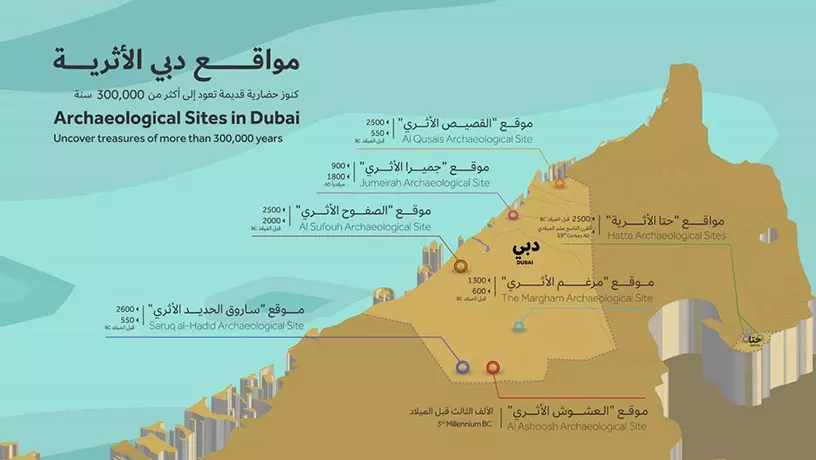
Archaeological sites in Dubai tell the history of the Emirate
Over the years, many archaeological sites have been discovered in Dubai that tell the story of the Emirate, going back more than 300,000 years: from the Lower Paleolithic (1,500,000-300,000 BC) and Neolithic (8,000-4,000 BC) to the late Islamic era (19th century AD).
At the top of the list is the archaeological site of Saruk al-Hadid (2600-550 BC), which was discovered in 2002. The site is believed to have been a centre for smelting Iron Age metals. Excavations have unearthed a treasure trove of rare artefacts including bronze, pottery and stone vessels, weapons, decorative shells, thousands of precious and semi-precious stone beads, various local and foreign seals, and many unique gold and silver items.
Equally interesting is the Islamic-era Jumeirah (900-1800 AD), the remains of an ancient city reflecting the prosperity of Islamic civilisation in the 10th century. It includes 12 historic buildings, nine of which are residential, as well as a caravanserai, a mosque and a marketplace.
The archaeological site of Al-Sufukh (2500-2000 BC) contains the remains of a settlement dating back to the third millennium BC. During excavations, three excavated tombs dating back to the Umm Al Nar civilisation were discovered, along with numerous skeletal remains, copper weapons, stone and pottery vessels, beads, shells and cylindrical seals.
Al Ashoush Archaeological Monument (3rd millennium BC) is considered one of the unique sites found in the interior desert areas of Dubai. Al Qusais Monument (2500-550 BC), discovered in the 1970s, contains a large settlement dating from the Bronze and Iron Ages, including a cemetery with approximately 120 individual and communal graves, as well as hundreds of artefacts.
The archaeological site of Margham (1300-600 BC) is a semicircular shaped tomb containing a skeleton surrounded by several funerary gifts, including soft stone bowls and a small bronze bowl, as well as 10 bronze arrowheads.
The tombs of Jabal al-Yamh (2500-1300 BC), where archaeological research has uncovered 84 tombs scattered beneath the mountain slopes and characterised by an architectural style dating back to the Hafit, Umm Al Nar, Wadi Suq and Iron Age civilisations. Some 29 tombs have been restored so far, and Dubai Culture is currently working on a comprehensive conservation plan for the remaining finds at the site.
Source: Khaleej Times
Follow our Telegram Chanel








